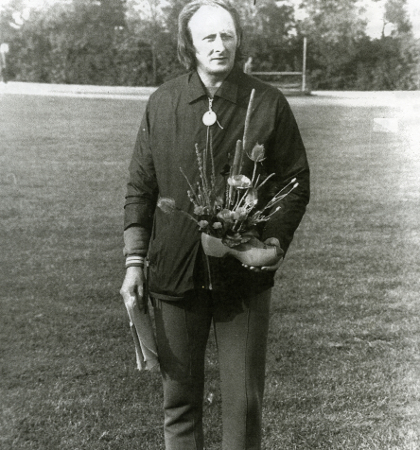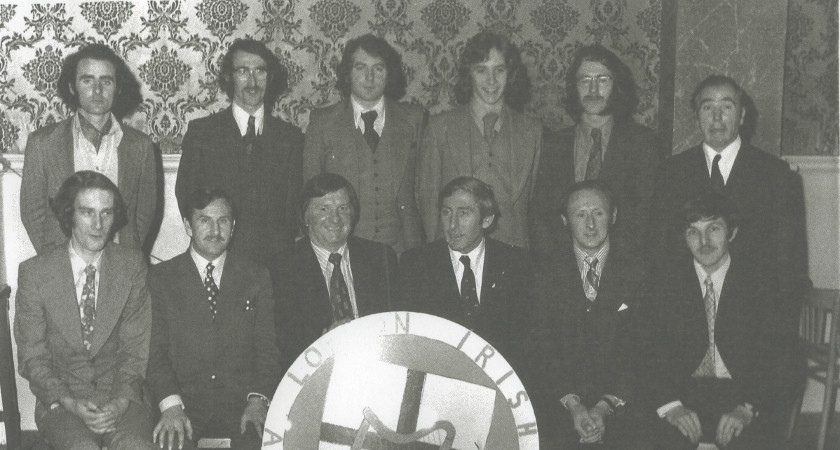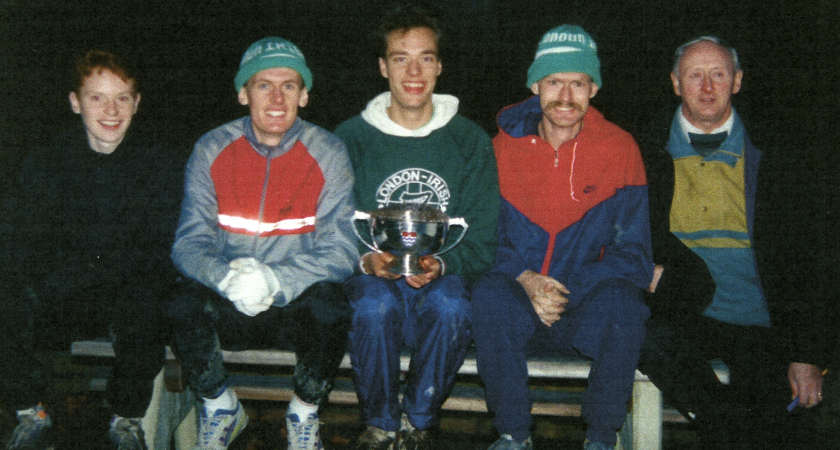AS Rio 2016 commences amid a dark cloud of uncertainty, the words of Brazil’s most-loved sporting son Ayrton Senna never sounded so poignant.
Asked who his greatest ever rival was, the legendary Formula One driver named not Alain Prost, but Terry Fullerton, his old team-mate from his early karting days.
“It was pure racing, there wasn’t any politics, and no money involved either, it was real racing.”
The same words could be used to describe the now defunct London Irish Athletics Club.
Pinpointing the precise year LIAC died has not been an easy task and, as yet, it remains undetermined. Prominent former member Paddy McGrath reckons it went under around 2002, but fellow club stalwart John Downes says it was still going when he returned to Ireland in 2007.
John Creane, meanwhile, insists he was a member until 2010 – “I still am, in spirit” – while Mike McCarthy still writes ‘London Irish’ anytime he’s asked for a club name when entering a race.
Whatever the date, it’s somewhat irrelevant. What is important and without any doubt is that it touched the lives of many immigrants, from Olympic gold medalists to bog standard cross country also-rans.
Founded in 1969 by Cork native John Dorgan and peers, the club wore green vests with white and black hoops and were based at the West London Stadium, now named the Linford Christie Stadium, where they shared a healthy rivalry with the Thames Valley Harriers, one of London’s most prestigious clubs.
“When we were at the Southern Leagues and the National Leagues, you could hear us miles away – we were the loudest shouters and supporters of each other,” recalls former Ireland international John Downes. “You’d have supporters from Thames Valley shouting ‘up the Valley, come on the Valley’ in posh accents, and then you’d have us lot swearing and screaming, but we just enjoyed it, we had a great time of it.”
Though the Valley may have considered themselves a class above LIAC, they kept a watchful eye on their noisy neighbours to the point where they almost used them as a feeder club, pinching their most talented sprinters when the time was right.
Sprinters such as Linford Christie himself, who would find worldwide fame by winning gold in the 100 metres at the 1992 Olympics, building on his two silvers (100m and 4x100m relay) in Seoul four years earlier.
![Linford Christie began his career with London Irish [Picture: Getty]](https://media.irishpost.co.uk/uploads/2016/08/Linford-Christie-N.jpg) Linford Christie began his career with London Irish [Picture: Getty]
Linford Christie began his career with London Irish [Picture: Getty]“We'd say 'yeah, yeah' to keep him going, but of course it was true, Linford was in London Irish.”
He certainly was, and not only does he remember his early days with great fondness, Christie feels he owes the club for preventing him from wasting his talent.
“I was a member of the club for quite a few years,” he tells The Irish Post. “It was the late 70s and early 80s. I must have been 17 or 18 when I joined London Irish. I had a few friends from my school days who were members already and they encouraged me to join.
 LIAC founder John Dorgan
LIAC founder John Dorgan“Thames Valley was the more established club and had some of the bigger international sprinters. So as young men, if we didn’t have London Irish to join, to be honest, maybe we would have slipped through the net.
“London Irish gave us the competition that we needed at that age. If I’d have joined Thames Valley first, I wouldn’t have been given the opportunity to compete because I wasn’t at their level yet, they were international athletes.
“One of my big breakthroughs, actually, was when we competed against Thames Valley in a championship. We were able to go up against the same guys we were seeing down at the track and I think I turned a few heads that day.”
Growing up in Shepherd’s Bush, close by the track that would later be named after him, logistics certainly played a part in Christie joining LIAC, but even so, by many accounts he was a hard man to get out of the house for training.
“Pat Fitzgerald, a guy who was with the club back then, used to have to go down to Linford’s house, pick him up and take him to training and races,” claims an amused Paddy McGrath.
Jamaica-born Christie literally laughs off the suggestion that he lacked dedication in his late teens, dodging the topic by saying: “It was a long time ago!”
In fact, much of Christie’s reminiscing of the club is filled with laughter, even the mere mention of influential leader John Dorgan set him off again.
“Oh yeah, I knew John [laughing], he sure was a character. He was a good guy, he always made sure we got to the meetings and everything else. Even when we were training he was one of the guys who would be yelling at us to ‘stick at it’.”
Dorgan sadly passed away on May 26, 2013 at the age of 76. Some say that was the date LIAC truly died. A former hurler for London and the old Brian Boru club, and originally Glen Rovers back in Cork, Dorgan was also a big rugby fan, but his true passion was athletics.
Mention his name to any former member of LIAC and a moment of quiet reflection usually ensues, before an outpour of emotional recollections.
“I attended John Dorgan's funeral, which was a sad day,” says John Creane, who joined the club in 1991.
“He was really the life and soul of the club, an immense character who inspired us all. He seemed to be everywhere on a cross country course shouting and hollering at us all to give more. A great man indeed and truly irreplaceable. Like an Alex Ferguson of the athletics world.”
 John Dorgan, pictured bottom row second from right, with fellow original members in 1969
John Dorgan, pictured bottom row second from right, with fellow original members in 1969John Downes, who joined in 1988, remembers Dorgan for getting the best out of him, while his influence off the track was just as strong.
“He really would motivate me,” says Downes. “If I wasn’t having a particularly great race, John didn’t spare. A lot of people didn’t like to be swore at in terms of being egged on, but the more he did it at me the more it worked for me.
“I suppose he just knew what made me tick. He was very good to me and he was very kind and helpful in a lot of ways, even outside of running. He was always there when I needed him, and all he wanted in return was for you to turn out for the club.”
No one disputes Dorgan’s status as the man behind the success of the club, but there were others around him who played a big part in the upkeep.
“Dorgan was the main man, he kept it afloat for years along with Mick Lyons and PJ Fagan, who has sadly passed on as well,” says Paddy McGrath in his distinct Belfast accent.
“PJ was a cracking runner, one of the best veterans we had. He helped hold it together financially.”
Yet when McGrath joined in 1985, the club was at a low ebb. Linford Christie had moved on and times were tough.
![Ade Mafe in his LIAC top [Picture: Getty]](https://media.irishpost.co.uk/uploads/2016/08/Ade-Mafe-LIAC.jpg) Ade Mafe in his LIAC top [Picture: Getty]
Ade Mafe in his LIAC top [Picture: Getty]The brothers in question were the Klimes twins, Petr and Pavel, who in 1987 claimed first and second place in the Dublin Marathon.
“These guys were world-class athletes,” recalls McGrath. It was a turning point for London Irish. With the club gaining momentum, another star signing arrived by the name of Ade Mafe in 1987.
Contrary to popular belief among former members, sprinter Mafe was not a London Irish athlete when he shocked the world by reaching the 200m final for Great Britain in Los Angeles ’84 at the age of 17.
But how did such an elite athlete end up at London Irish with Seoul ’88 on the horizon?
“I used to run for Hounslow and my coach fell out with the people who were running the club,” Mafe told The Irish Post.
“Back then, we used to run against a lot of guys from west London who ran for London Irish. We’d run relays against them and with them – they were all good guys – and so we decided to just join them at London Irish because we knew them.
“The club was full of great people, good honest Irish folk who had no complaints [about non-Irish joining]. There was a guy there called Mick Lyons, he was very loyal, treated us well, and we rewarded that with loyalty in return.
“Thames Valley, at that time, was very much run by typical athletics people, while London Irish just welcomed you with open arms and you didn’t feel that sort of British stuffiness. It was pretty easy going.”
In many ways, London Irish became a home for minorities.
“The likes of Ade and Linford were great for us,” said Downes, who brought the club’s long-distance prowess up a notch when he arrived in 1988.
“We didn’t see colour, we just saw people. We weren’t into religion, race, creed – none of that craic – we were just interested in people, and if you were up for having a bit of a laugh and enjoyed being with a boisterous crowd, you were the right fit.”
By now, the club was flying, and at the turn of the decade a milestone was reached – promotion to the British League in 1990, the top division, where they would stay for a handful of seasons.
The following year was arguably the finest in the club’s history, peaking with the Southern Six-Stage win in Aldershot, a feat which would put LIAC on the front cover of Athletics Weekly magazine on October 2, 1991.
Indeed, it was the second time the club had graced the cover of the prominent publication that year, with Ade Mafe’s exploits at 400m earning him a place on the front in his LIAC vest on February 13, 1991. The Irish Post took notice of their progress too, with regular updates on the back pages in the early 90s, while a photographer by the name of Jim Regan captured their every move between 1990 and 1993.
That was perhaps as good as it got for LIAC as a whole. Relegation ensued, Mafe left for Thames Valley, and the club slowly faded into obscurity. There were still highs thanks to fine athletes like Tommy Maher, Seamus Kerr and Cormac Finnerty – who went on to run for Ireland at the 1996 Olympics – plus David Burke, and plenty of other internationals who used London Irish as a stop-off for their time living in London.
“After PJ Fagan died, John Dorgan was finding it very hard to keep it together,” recalls Paddy McGrath. “I coached the club for a few years while I was still living down in west London. We had some good young lads coming through, some good junior teams and some good senior teams, but then I moved out to Berkshire in 2002 and eventually started my own club here.”
 Former members of LIAC celebrate success with John Dorgan, right
Former members of LIAC celebrate success with John Dorgan, rightJohn Downes gave everything for the green vest too, but he cites LIAC’s lack of affiliation to a London borough as reason for the wheels coming off.
“It was too hard to recruit; we couldn’t encroach on other peoples’ territory. A lot of it relied on word of mouth, we may have got word that someone was arriving from Ireland, New Zealand, South Africa, wherever. Wherever we could grab somebody from to join the club, we would.
“What we achieved was great because we had no funding. We had no help from any borough, so I suppose we punched way above our weight. To get medals at national level in the south of England was extremely good going.
“The fact that it doesn’t exist anymore is probably the saddest part of it.”
McGrath concurs. “Everything evolves, people get old and move on,” he says. “We really were a great club and contributed an awful lot to athletics in this country.”
John Creane says the club is “dearly missed” by the Irish community, while Linford Christie acknowledges its eventual demise as “a real shame”.
However, as politics, economics and scepticism threaten to leave muddy footprints after the 2016 Games, sport will always have the laudable legacy of the likes of London Irish Athletics Club.

